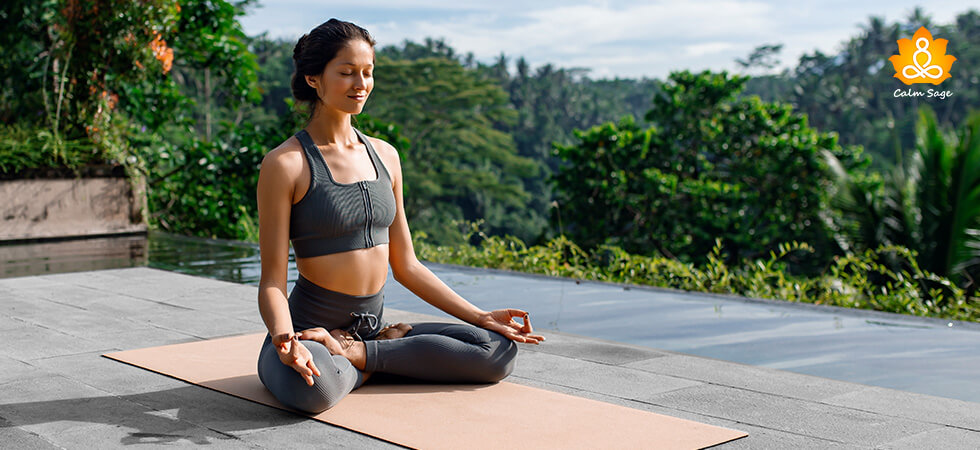Breathwork 101: 5 Simple Breathwork Techniques for Beginners

As stressful life has become lately, there’s hardly any time for relaxation. Because of the lack of self-care time, the need to practice quick relaxation techniques is increasing and one of those techniques can include breathwork and meditation. More people these days are adding meditation and breathing techniques to their self-care routine and for good reason too!
It is found that breathwork techniques not only help improve your physical and mental health but also help clear your mind and calm your stress. If you’re new to breathwork techniques, then do not worry! I have brought a simple guide that you, as a beginner to breathwork techniques, would find insightful and helpful.
Now, I know you must be feeling confused about what exactly is breathwork. And it’s good to be curious. Before you blindly decide to add something you’re not completely sure of or aware of to your daily routine can be dangerous. Let’s first learn what breathwork is at a glance and then what breathing techniques you can try as a beginner.
Breathwork At a Glance

Considered a mindfulness activity, breathwork is a practice that combines different breath control techniques. If we trace the origins of breathwork and breathing techniques, we can find their traces back to India. However, modern breathwork techniques were first introduced and became popular back in the 1970s.
Most of us have gradually developed the habit of breathing shallowly. What we don’t understand is that shallow breaths can trigger the ANS (Autonomic Nervous System) and put our nervous system in a constant state of stress, triggering the flight-fight-freeze response. While stress can be good in certain situations, living in a constant state of stress response can be harmful to our overall health.
When you practice breathwork techniques, you trigger the opposite of stress response aka the rest-and-digest response, also known as the parasympathetic nervous system. When the parasympathetic nervous system is triggered, it informs the body that it’s time to rest, allowing your mind and body to feel calm and relaxed.
You can also use breathwork as an active type of meditation which can help you disconnect from the turbulence in the mind and focus on the present moment. With breathwork, you release the negative thoughts, beliefs, and behaviors that hold you back and you return to the present as you begin to feel better equipped to deal with the anxiety and stress.
The Amazing Benefits of Breathwork
Many of us practice breathwork techniques to release stress, but there are other hidden yet amazing benefits of breathwork. Some of the common breathwork benefits include;
- Lowers anxious thoughts and feelings
- Increases energy
- Boosts the immune system
- Lowers blood pressure
- Improves breathing
- Regulate pain
- Boosts self-esteem and mood
- Better sleep
- Control symptoms of depression
- Promotes trauma healing
Getting Started With Breathwork: The Techniques For Beginners

These are some of the breathing meditation techniques for beginners that you can get started with today!
1. Diaphragmatic Breathing
Also known as abdominal breathing or belly breathing, this breathwork technique is an easy and deep breathing technique that you can practice even if you’re new to breathwork. This practice involves breathing from the belly and can be used to calm your shallow breathing and release stress when you’re too overwhelmed.
Here’s how you can practice this breathing technique;
- Sit down in a comfortable position or lie on your back on a flat surface
- Place one hand on your belly and the other on your chest
- Inhale slowly through your nose and feel the belly push outward against your hand
- Exhale slowly through your mouth and feel as the belly relaxes. Make sure your chest remains still under your hand
- Repeat this breathing pattern as many times as you want or until you feel calm and relaxed
2. Box Breathing or 4-4-4-4 Breathing
This is another easy breathing technique that is perfect for beginners. All you need to do is inhale, hold, exhale, and pause. Simple, right? Box breathing technique is also referred to as 4-4-4-4 breathing or square breathing as the amount of inhaling, holding, exhaling, and pausing is for 4 seconds. This breathwork exercise is good for promoting natural breathing and reducing anxiety.
Here’s how you can practice box breathing;
- Sit in a comfortable position or lie on your back on a flat surface
- Inhale slowly through your nose for a count of 4
- Hold your breath for a count of 4
- Exhale through your mouth for a count of 4
- Hold your breath for a count of…you guessed it…4!
- Repeat as many times as you require
3. 4-7-8 Breathing Exercise
Another easy, deep breathing exercise good for beginners is the 4-7-8 breathing exercise. This is a very simple breathwork technique that you can practice as many times in a day or whenever you feel particularly anxious or stressed. This breathing exercise helps promote relaxation and is also recommended for improving sleep.
Here’s how you can practice this breathwork meditation technique;
- Sit in a comfortable position or lie on your back on a bed or flat surface
- Inhale slowly through your nose for a count of 4
- Hold your breath for a count of 7
- Exhale slowly through your mouth for a count of 8
- Repeat the steps as many times as it takes to relax your muscles and calm your breathing
4. Alternate Nose Breathing or Nadi Shodhana
Also known as “Anulom Vilom”, this alternate nose breathing technique is also a great breathwork exercise for beginners. This breathwork technique involves controlling your breaths through your nostrils and it is believed that practicing Nadi Shodhana can benefit your respiratory system greatly.
You can practice this simple breathwork technique by following these steps;
- Sit in a comfortable and straight posture on a flat surface
- Put your left thumb on your left nostril or alternatively, you may put your right ring finger on your left nostril
- Inhale slowly through your right nostril
- Lift the thumb (or ring finger) off the left nostril and place the ring finger of your left hand or the thumb of your right hand on the right nostril
- Exhale slowly through the left nostril
- Next, inhale through your right nostril following the same steps as above, and exhale through your left nostril
- Repeat this process for at least 10 minutes as many times a day as you want
5. Coherent Breathing or 5-5 Breathing
Did you know that we breathe at a rate of 2–3 seconds per minute? The 5-5 breathwork technique, also known as coherent breathing, is a way to control and slow your breathing to 4–5 seconds per minute. This is a conscious way of breathing that will help you breathe slowly, if not deeply. This breathwork exercise can also bring a sense of calm and relaxation as you practice it.
You can start with the 5-5 breathing by following these steps;
- Focus on the rhythm of your breathing
- For a minute, inhale for 4 seconds, and exhale for 4 seconds
- Once you’re comfortable, increase the count and for a minute, inhale for 5 seconds, and exhale for 5 seconds
- Again, once you’re comfortable, increase the seconds count by 6 and so on…
- Repeat the breathwork until you’re breathing naturally and are conscious of each breath you’re taking
What Next?
If you’re a beginner to breathwork techniques and are confused about where to begin, here are some ways for you to start your breathwork journey;
- You can attend a workshop or class near you. Having an instructor to work with can be a comfort especially if you are new to breathwork.
- You can also join an online class or group. There are also guided breathwork exercises you can try online.
- If you’re a breathwork beginner, then you can also use a meditation app or breathwork app to help you get started.
One of the best ways to know which breathwork technique is best for you is to first see what it is you’re looking for or what you wish to achieve through the practice. Once you know this, you can work with different techniques and see which one works best for you or you’re comfortable with. Don’t hesitate to ask for guidance or experiment with different breathing techniques.
I hope this blog helped you understand the different breathwork techniques for beginners and how you can use them to calm your mind and body. Feel free to write to us for more at info@calmsage.com or leave us a message on social media.
You can also share your favorite breathing meditation techniques in the comments below.
Take Care!




















